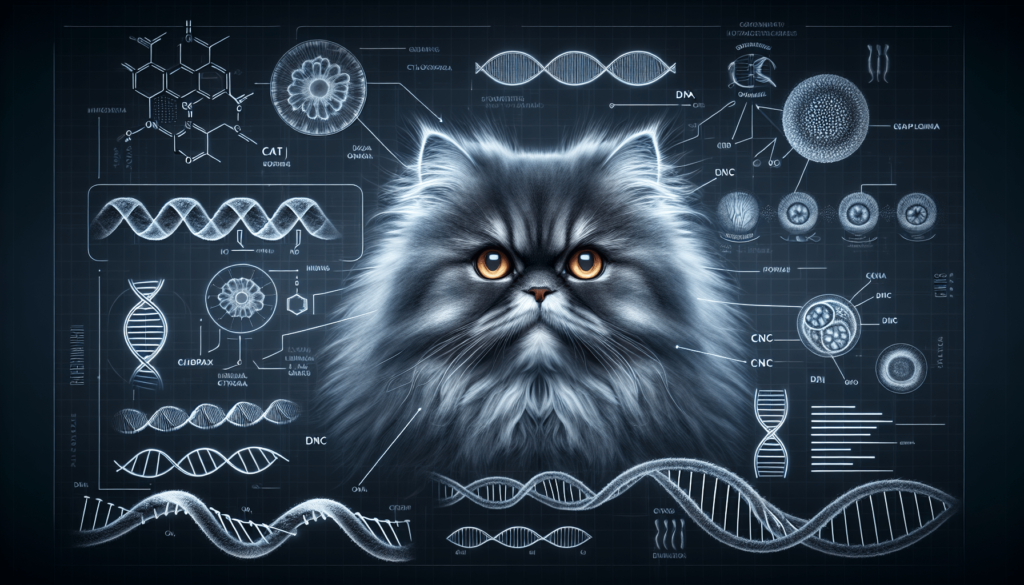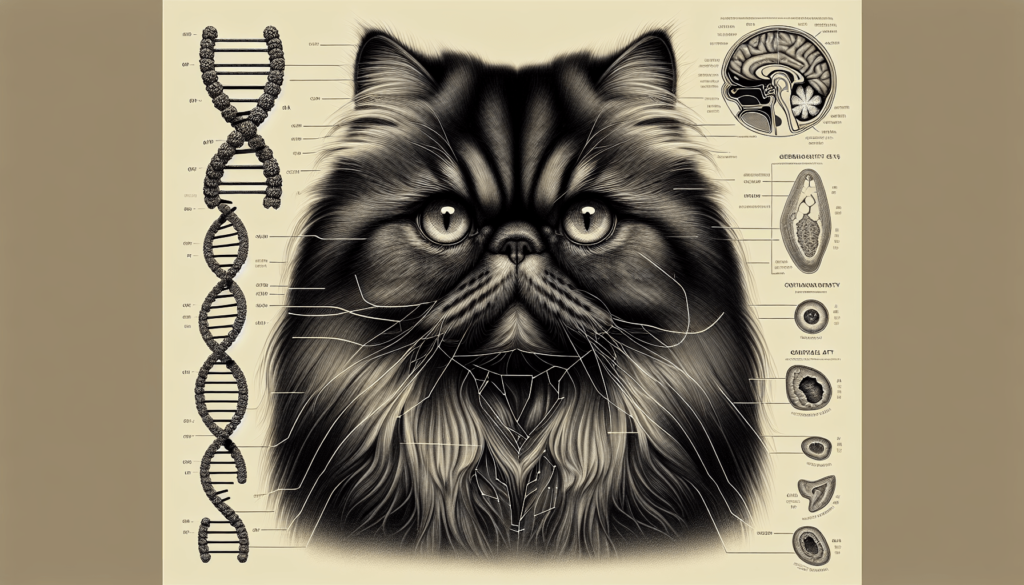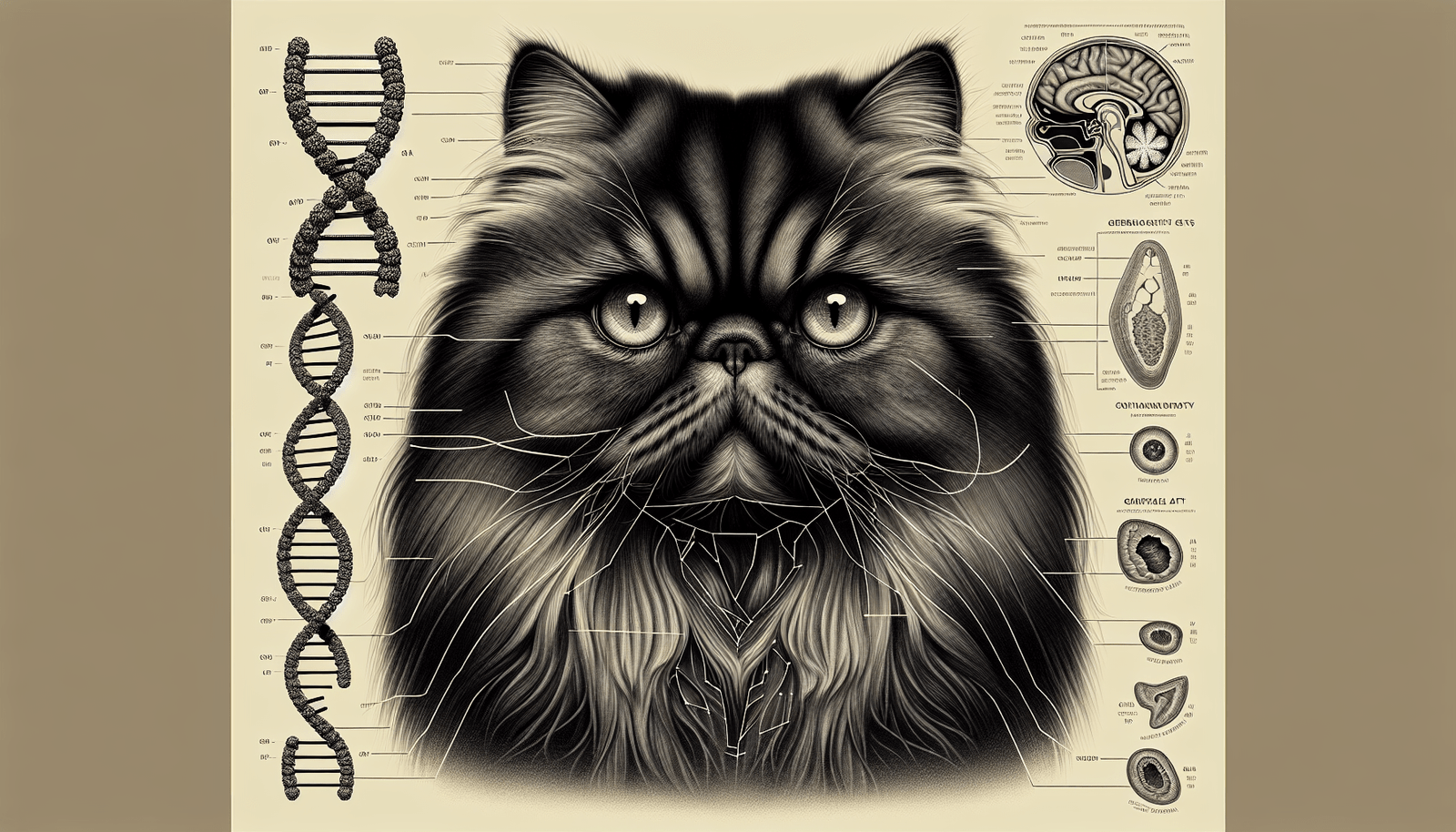If you’ve ever wondered about the genetic makeup of Persian cats, you may have come across the question lingering in your mind: “Are Persian cats genetically deformed?” With their distinctive features, such as their flat faces and long, luxurious coats, these cats certainly hold a charm unlike any other breed. In this article, we’ll explore the genetics behind these unique characteristics, shedding light on whether these feline friends are truly prone to deformities or if there’s more to their story.
Understanding Persian Cats
Physical characteristics of Persian cats
Persian cats are known for their distinctive physical appearance. They have a round face with a short, broad nose. Their large, round eyes are typically various shades of blue, copper, green or amber. Persian cats have a strong, muscular body covered in a long, thick coat that comes in a wide range of colors and patterns. Their luxurious fur often requires regular grooming to prevent matting. Additionally, Persian cats have a stocky build and a short, sturdy neck.
History and origin of Persian cats
The history of Persian cats can be traced back several centuries, with their origins believed to be in the region that is now Iran. Persian cats gained popularity during the 17th century and were highly prized for their elegant appearance. They were initially imported to Europe by traders, where they quickly captivated cat lovers with their unique beauty. Over time, breeding programs were established to refine and enhance the breed’s characteristics, leading to the Persian cat we know today.
Popularity and recognition as a cat breed
Persian cats have long been recognized as one of the most popular and beloved cat breeds. Their distinctive appearance and gentle demeanor make them highly sought after as pets. The Persian breed has gained significant recognition and acclaim within the cat fancy community, with various cat associations recognizing the breed and its specific standards. Persian cats are often featured in cat shows and competitions, where their beauty is celebrated and admired.
Genetic Considerations
Genetic variations and mutations in Persian cats
Like all living creatures, Persian cats possess unique genetic variations and mutations that contribute to their characteristics and physical traits. These genetic variations have been selectively bred over time to enhance certain desirable traits, such as coat color, body shape, and facial structure. However, it is important to note that these genetic variations can also be associated with health issues, which should be taken into account by responsible breeders.
Possible genetic health issues
Due to the selective breeding practices that have focused on certain physical traits, Persian cats are more prone to certain genetic health issues. One example is polycystic kidney disease (PKD), a genetic disorder that causes the formation of cysts in the kidneys and can lead to kidney failure. Another potential health concern is hypertrophic cardiomyopathy (HCM), a genetic heart condition that affects the structure of the heart muscles. These and other genetic health issues should be carefully monitored and addressed by breeders and owners.
Medical conditions related to genetic factors
In addition to specifically genetic health issues, Persian cats may also be prone to certain medical conditions that are influenced by genetic factors. For instance, brachycephalic syndrome, characterized by respiratory difficulties due to the facial structure, is more common in Persian cats due to their short, flat faces. Dental issues and misalignment can also be seen in Persian cats, requiring regular dental care. It is crucial for owners to be aware of and proactive in managing these conditions to ensure the overall well-being of their Persian cats.

Breeding Practices
Selective breeding for certain traits
Selective breeding is a common practice in producing specific breed characteristics and maintaining breed standards. For Persian cats, breeders selectively breed for traits such as the long and luxurious coat, round face, and large eyes. By carefully selecting cats with the desired traits and excluding those without them, breeders can shape the appearance of the breed over generations. This has led to the iconic Persian cat look that is widely recognized and admired today.
Consequences of extreme selective breeding
While selective breeding has undoubtedly contributed to the unique beauty of Persian cats, it has also resulted in some unintended consequences. The emphasis on certain traits, such as the flat face and short nose, can lead to health problems like respiratory difficulties and eye-related issues. These consequences highlight the need for responsible breeding practices that take into account not only aesthetics but also the overall health and well-being of the cats.
Controversies surrounding breeding practices
The extreme selective breeding practices employed to achieve the desired characteristics of Persian cats have sparked debates and controversies within the cat breeding community. Some argue that the pursuit of exaggerated features has led to an increased risk of health problems and compromised the welfare of the breed. Others believe that responsible breeding practices can mitigate these concerns. It is essential for breeders, organizations, and owners to engage in open discussions and make informed decisions to promote the breed’s health and integrity.
Physical Health Concerns
Brachycephalic syndrome
Persian cats are known for their brachycephalic (shortened) faces, which can contribute to a condition known as brachycephalic syndrome. This syndrome is characterized by respiratory difficulties due to the altered anatomy of the skull and airways. Affected cats may experience snorting, wheezing, and difficulty breathing, particularly in hot or stressful environments. It is important for Persian cat owners to be aware of these potential issues and provide appropriate care and environmental modifications to ensure the comfort and well-being of their pets.
Polycystic kidney disease (PKD)
Polycystic kidney disease is a genetic disorder that is commonly seen in Persian cats. It involves the formation of fluid-filled cysts in the kidneys, which can lead to the progressive loss of kidney function. Regular monitoring and early detection through genetic testing are crucial in managing PKD and ensuring the best possible quality of life for affected cats. Responsible breeders should prioritize the exclusion of PKD-positive cats from their breeding programs to reduce the prevalence of this condition within the Persian cat population.
Dental issues and misalignment
Persian cats are prone to dental issues and misalignment due to their unique facial structure. The shortened jaw and crowded teeth can lead to dental problems such as tooth decay, gum disease, and tooth misalignment. Regular dental care, including regular toothbrushing and professional cleanings, is essential in maintaining their oral health. Persian cat owners should consult with veterinarians to develop a dental care plan tailored to their cat’s specific needs.
Heart conditions and hypertrophic cardiomyopathy (HCM)
Hypertrophic cardiomyopathy is a genetic heart condition commonly found in Persian cats. It involves the thickening of the heart muscles, which can lead to abnormal heart function and potentially life-threatening complications. Regular cardiac screenings, including echocardiograms, can help identify signs of HCM early on. Persian cat owners should work closely with their veterinarians to monitor their cat’s heart health and manage the condition if diagnosed.
Skin and coat problems
The long and dense coat of Persian cats requires regular grooming to prevent matting and maintain its health and luster. Without proper grooming, their fur can become tangled and contribute to skin issues, such as irritation, dryness, and infections. Regular brushing, bathing, and attention to hygiene are essential to keep their skin and coat in optimal condition. Persian cat owners should establish a grooming routine and be prepared to invest time and effort into maintaining their cat’s coat.

Ocular Health Issues
Eye structure characteristics of Persian cats
Persian cats are known for their captivating eyes, but their unique eye structure can make them prone to certain ocular health issues. The combination of a flat face and large, round eyes can result in conditions such as tear duct blockage, excessive tear production, and eye infections. The prominence of their eyes can also make them vulnerable to external factors that may cause injury.
Tear duct blockage and excessive tear production
The flat face and round eyes of Persian cats can lead to tear duct blockage or narrowing, impairing the normal drainage of tears. This can result in excessive tear production, leading to damp fur around the eyes and potential skin irritation. Regular cleaning of the eye area and monitoring for signs of infection or discomfort are necessary to maintain eye health in Persian cats.
Entropion and ectropion
Entropion is a condition where the eyelids fold inward, causing the eyelashes to rub against the cornea. Ectropion, on the other hand, involves the eyelids turning outward, leaving the cornea exposed. Both conditions can cause irritation, discomfort, and potential damage to the eye. Persian cats may be more susceptible to these conditions due to the shape and position of their eyes. Regular veterinary check-ups and early intervention are crucial to manage and treat entropion or ectropion.
Progressive retinal atrophy (PRA)
Progressive retinal atrophy is a group of genetic disorders that affects the retina, leading to progressive vision loss and potentially blindness. Persian cats can be at higher risk for certain types of PRA due to their genetic predispositions. Regular eye examinations and genetic testing can help identify the presence of PRA and allow for appropriate management measures to be implemented to slow its progression and preserve the vision of affected cats.
Cataracts
Cataracts are characterized by the clouding of the lens within the eye, leading to impaired vision. Persian cats may develop cataracts as a result of aging or underlying genetic factors. Regular eye exams can help detect cataracts early, allowing for timely interventions such as surgery, if necessary, to improve the cat’s quality of life. Proper eye care and monitoring are essential in maintaining the ocular health of Persian cats.
Responsible Breeding and Ethics
Importance of responsible and ethical breeding
Responsible and ethical breeding practices play a crucial role in promoting the overall health and well-being of Persian cats. Breeders should prioritize the health and temperament of their cats, selecting animals with the fewest genetic health issues possible. This includes regular health screenings, genetic testing, and consultation with veterinarians to ensure the welfare of the breed. Responsible breeders also prioritize finding suitable and loving homes for their kittens, taking into account the unique needs of the Persian cat breed.
Health screening and genetic testing
To mitigate the risk of passing on genetic health issues, responsible breeders conduct health screenings and genetic testing for potential breeding cats. This helps identify any potential health concerns that may affect the offspring and allows breeders to make informed decisions about the suitability of breeding pairs. Genetic testing can detect the presence of certain conditions, such as PKD or PRA, allowing for proactive management strategies and reducing the transmission of these conditions within the breed.
Efforts to reduce breed-related health problems
Awareness of breed-related health problems in Persian cats has led to efforts to improve the breed’s overall health. Responsible breeders collaborate with veterinarians and researchers to address specific health issues. By sharing information, implementing improved breeding practices, and prioritizing the welfare of the cats, breeders can work towards reducing the prevalence of genetic health issues within the Persian cat population. Ongoing research and advancements in veterinary medicine also contribute to identifying and managing health concerns in the breed.
Caring for Persian Cats
Regular grooming and maintenance
Proper grooming is essential for maintaining the health and appearance of Persian cats. Their long and dense coats require regular brushing to prevent mats and tangles, which can lead to discomfort and skin irritation. Regular bathing is also necessary to keep their coat clean and free from oils and debris. Additionally, routine care such as trimming their nails, cleaning their ears, and brushing their teeth should be part of a comprehensive grooming routine to ensure the overall well-being of Persian cats.
Proper nutrition and feeding requirements
Persian cats have specific dietary needs that should be met to support their overall health and maintain a healthy weight. High-quality cat food that is specifically formulated for Persian cats can help meet their unique nutritional requirements. It is important to provide a balanced diet, avoiding excessive treats or human food that may lead to weight gain or nutritional imbalances. Cat owners should consult with veterinarians to determine the appropriate feeding regimen for their Persian cats.
Exercise and enrichment for a healthy lifestyle
While Persian cats are generally less active than some other breeds, regular exercise and mental stimulation are still crucial for their overall well-being. Engaging in play sessions with interactive toys or providing climbing structures can help promote exercise and mental enrichment. However, it is important to consider the physical limitations of Persian cats and provide opportunities for exercise that are suitable for their individual needs and comfort levels.
Regular veterinary check-ups and preventive care
Regular veterinary check-ups are essential for maintaining the health of Persian cats. Routine examinations allow veterinarians to monitor their overall health, detect any potential health issues early on, and provide appropriate preventive care, such as vaccinations and parasite control. Persian cat owners should establish a relationship with a trusted veterinarian and ensure that their cats receive regular check-ups and preventive care tailored to their individual needs.
Persian Cats in Show Competitions
Breed standards and judging criteria
Persian cats are a popular breed in cat shows and competitions, where they are judged based on specific breed standards. These standards outline the desired physical characteristics, including body type, facial features, coat quality, and coloration. Judges evaluate each Persian cat according to these standards, emphasizing the breed’s unique aesthetics and adherence to the ideal breed representation.
Controversies surrounding show standards
The emphasis on certain physical traits in show standards, particularly the extreme features of Persian cats, has sparked controversies within the cat show community. Critics argue that these standards prioritize aesthetics over the cats’ health and well-being. They believe that show standards that promote exaggerated features can perpetuate and even worsen health issues in the breed. Discussions and debates surrounding these controversies continue as efforts are made to balance breed standards with the health and welfare of the cats.
Impact of breed-related health issues on showing
The presence of breed-related health issues can have an impact on the participation of Persian cats in show competitions. Cats with significant health issues or visible discomfort may be excluded from showing to prioritize their well-being. Some cat associations have implemented health screening requirements to ensure that cats participating in shows are in good overall health. The focus on responsible and ethical breeding and the promotion of the breed’s health are crucial in strengthening the integrity of Persian cats in show competitions.
Persian Cats as Pets
Adaptability to different living environments
Persian cats are known for their calm and gentle nature, making them adaptable to various living environments. They can thrive in apartments or houses and are generally well-suited to indoor lifestyles. Persian cats are typically not as active as some other breeds, making them a suitable choice for individuals or families who prefer a more relaxed and less demanding companion.
Temperament and personality traits
Persian cats are often described as sweet-natured, docile, and affectionate. They enjoy a peaceful and quiet environment, making them excellent companions for those seeking a calm and relaxed pet. Persian cats are known for their love of attention and often form strong bonds with their owners. Their laid-back demeanor and tendency to be less active make them a good choice for individuals or families looking for a loving and low-energy pet.
Special considerations for Persian cat owners
Owning a Persian cat requires a commitment to their specific needs. Their long and dense coats require regular grooming to prevent matting and keep their skin healthy. The potential risks associated with their flat faces, such as respiratory difficulties and ocular health issues, should also be considered. Persian cat owners should be prepared to invest time and effort into maintaining their cat’s overall health and well-being.
Pros and cons of owning a Persian cat
Owning a Persian cat comes with its own set of pros and cons. The pros include their stunning appearance, affectionate nature, and compatibility with various living environments. They provide companionship and often form deep bonds with their owners. However, the grooming and maintenance required for their long coats can be time-consuming, and their potential health issues may require extra care and attention. Prospective owners should carefully consider these factors to ensure they can provide the necessary care for a Persian cat.
Conclusion
Appreciating the beauty and uniqueness of Persian cats
The distinctive physical characteristics of Persian cats, such as their round faces, large eyes, and luxurious coats, make them truly unique and captivating. Their beauty is celebrated and admired by cat lovers around the world, contributing to their enduring popularity as pets.
Balancing aesthetics with health and well-being
While the aesthetic appeal of Persian cats is undeniable, it is crucial to ensure that their health and well-being are given equal consideration. Responsible breeding practices and a focus on promoting overall breed health are essential in preserving the integrity and longevity of the Persian breed.
Continued efforts to improve breed health
The cat fancy community, breeders, and organizations continue to work together to improve the health of Persian cats. Through research, health screenings, and the implementation of ethical breeding practices, efforts are being made to reduce the prevalence of genetic health issues and promote the overall well-being of Persian cats.
By understanding the genetic considerations, health concerns, and responsible breeding practices associated with Persian cats, owners can provide the necessary care and attention to ensure their beloved pets lead healthy and fulfilling lives. With proper care and responsible ownership, Persian cats can continue to bring joy and companionship to countless individuals and families.

